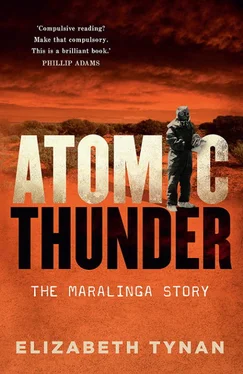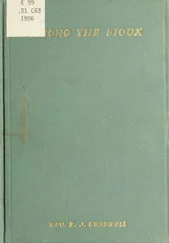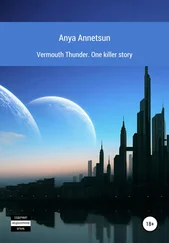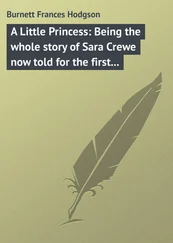Buffalo 4, another Red Beard test, exploded from a tower at Breakaway, was a bigger bomb, expected to yield 16 kilotonnes, though its actual yield was 10 kilotonnes. It was fired in the dead of night, at 12.05 am on 22 October. It would have been fired earlier, except 21 October was a Sunday, and the Australian Government banned Sunday tests for religious reasons. Five minutes after midnight made everything okay, apparently. The sight of a midnight atomic fireball must have been eerie. Buffalo 4 had a high cloud, in excess of 9000 metres, but those on the ground could not see it well because of low stratus cloud. The radioactive cloud swung north and headed towards Darwin. In the tradition of previous Buffalo shots, Buffalo 4 violated the firing conditions. Even as it was being fired, the test authorities knew that it would cause fallout in inhabited areas more than 160 kilometres from the Maralinga range, a clear violation of the agreement. In fact, it sprinkled radioactive fallout on an arc between Newcastle on the New South Wales coast and Darwin in the Northern Territory.
Buffalo had many controversial elements. In particular, this test series is notorious for the Indoctrinee Force, often referred to later as the Maralinga guinea pigs. This group, largely commissioned officers, was deliberately positioned in the forward area during the Buffalo major trials so they could witness and experience the effects of nuclear weapons close-up – less than 9 kilometres from ground zero. There were 283 men in the Indoctrinee Force. Most were from the UK – 172 officers and six civilians – while Australia contributed 100 (mostly army officers but 25 from lower ranks and one civilian) and New Zealand contributed five officers. They were under the direct command of Australian captain JH Skipper but under the general direction of the British scientist Drake Seager, who reported to Penney.
The members of the Indoctrinee Force were special. They were housed separately from the other Maralinga denizens. They stayed at Eleven Mile camp, which was 18 kilometres from Watson and about 64 kilometres south of the forward area. They received endless briefings, lectures and range tours. Because the first Buffalo shot was delayed for 15 days, the Indoctrinees also assisted the scientists in preparing and laying out the various objects that were to be subjected to the nuclear blasts, such as guns, cars and dummies. The Indoctrinees witnessed the first two Buffalo tests, One Tree and Marcoo, up close. The world was facing the real prospect of nuclear war, and the Indoctrinees were ordered to report back to their military colleagues what the future had in store. Their eyewitness accounts were expected to provide preparation for the reality of atomic warfare.
Major Peter Lowe finally arrives at Maralinga, after a long British Overseas Airways Corporation flight to Sydney via the Far East. He has ‘been volunteered’ for a special three-week mission in the Australian desert. His commanding officer called him, when he was working at his post in Münster, West Germany, to tell him the glad tidings. It is all very hush-hush, he was told, but there is a big show on in Australia that needs non-technical observers, and most of them are coming from the British Army. He was to join an elite group known to the AWRE as the Indoctrinee Force, or I-Force, a sinister-sounding designation, though not one the men themselves use or even know about. Major Dan Buckley, also in the British Army, soon joins Lowe. He was stationed at Woomera for the rocket tests not long ago and had no idea he would be back in Australia so soon, for an even more dramatic assignment. Buckley is young, sporty and fit, a boxer and rugby player in his spare time. Lowe and Buckley are in different Indoctrinee teams doing different things, but both form part of a major exercise at the first Maralinga major test series.
Their camp at Eleven Mile is tented and primitive, rather different from those in Münster or the UK – or even Woomera. They are away from the main Maralinga contingent in the tree-lined village, too. It soon becomes clear that their mission will take longer than three weeks, as the winds are never right and interfere with the test schedule. Time hangs heavily on the officers. While they wait, they are treated to lectures and other preparations. Penney’s lectures are interesting and well prepared. The same cannot be said for some of the other talks, which are boringly technical and hard to follow. But everyone enjoys hearing Sir William speak, even though his subject matter is grave. He has an amiable and egalitarian manner, and knows his stuff. Penney warns the men of the dangers of gamma rays and describes the measures that will be taken to protect them. They are to wear full protective suits and film badges. Designated members of the party will carry Geiger counters.
The Indoctrinees are frustrated by the delays to the first blast at One Tree. After the lectures, they take the time to prepare equipment that will be subjected to the atomic blast. They are officers, and this hard physical labour is not normally the sort of thing they do, but they are bored enough to welcome the activity. Lowe helps dig in 25-pounder guns, erect radio antennae and set out field telephones. Buckley has a particular responsibility for guns and is asked to ensure a range of damage from none at all to complete annihilation. He spaces his guns out from ground zero to achieve an even coverage. He has been told that this work will have implications for British Army equipment purchasing policies – guns that seem to survive an atomic blast will require fewer spares than those that are quickly destroyed.
When the day finally arrives, after a number of false starts, the Indoctrinees are stationed at Forward Control on a hillside only 8 kilometres away from the first explosion – far closer than the main party. They are all dressed in summer uniform of shorts, shirt and long socks. A minute before the blast, as one they turn around so they are facing away from the explosion. Buckley listens to the countdown – ‘4, 3, 2, 1, flash turn now!’ At ‘flash’ the sky explodes, and it feels like an oven door has been opened right next to their bare necks and knees. They can turn now, as the initial flash is over and the possibility of eye damage has lessened. Buckley spins around to see a coiling black mass, shot through with flames, rapidly reaching higher for the colder air and then gradually flattening into a mushroom shape. He and his colleagues see the blast wave rushing towards them, knocking over the vegetation in its path. Then the wave hits and the men rock on their feet.
After the blast, the Indoctrinees venture towards ground zero to see what the explosion has wrought. Lowe dons his gas mask, boots and the protective clothing they call goon suits and climbs onboard a 3-tonne truck to travel to the edge of the contaminated area. He heads a small group of eight men and holds the Geiger counter. The device gets more and more frantic as the men near the blast site. The conditions are clearly too radioactive, so the group heads back to the decontamination camp run by the Australians under the direction of Harry Turner near Roadside, a waypoint at the junction of the network of Maralinga roads. Lowe’s film badge is ripped unceremoniously from his lapel by a big, tall, brusque Australian sergeant and thrown into a bucket, without its number or reading being recorded. The bucket is full of film badges, none of which will ever be seen again by those who wore them.
Meanwhile, Buckley nears his forward gun location and is puzzled to see that the arid reddish-brownness of the desert earth has been replaced with a strange whiteness, the earth transformed by extreme heat into white glass. He reaches his leading gun position and calls out his Geiger counter reading to the health physics representative. The reading is off the dial, and he gets the urgent message from his base ‘Return immediately, return immediately. Report to Health Control’. He doesn’t need to be told again – he hurries away from the unnatural white glass that overlies the red dust.
Читать дальше












